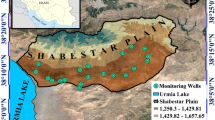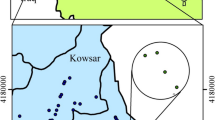Abstract
For groundwater conservation and management, it is important to accurately assess groundwater pollution vulnerability. This study proposed an integrated model using ridge regression and a genetic algorithm (GA) to effectively select the major hydro-geological parameters influencing groundwater pollution vulnerability in an aquifer. The GA-Ridge regression method determined that depth to water, net recharge, topography, and the impact of vadose zone media were the hydro-geological parameters that influenced trichloroethene pollution vulnerability in a Korean aquifer. When using these selected hydro-geological parameters, the accuracy was improved for various statistical nonlinear and artificial intelligence (AI) techniques, such as multinomial logistic regression, decision trees, artificial neural networks, and case-based reasoning. These results provide a proof of concept that the GA-Ridge regression is effective at determining influential hydro-geological parameters for the pollution vulnerability of an aquifer, and in turn, improves the AI performance in assessing groundwater pollution vulnerability.



Similar content being viewed by others
References
Al-Adamat, R. A. N., Foster, I. D. L., & Baban, S. M. J. (2003). Groundwater vulnerability and risk mapping for the basaltic aquifer of the Azraq basin of Jordan using GIS, remote sensing and DRASTIC. Applied Geography, 23, 303–324.
Aller, L., Bennett, T., Lehr, J. H., Petty, R. J. & Hackett, G. (1987). DRASTIC: A Standardized system for evaluating groundwater pollution potential using hydrogeologic settings. National Water Well Association, EPA-600/2-87-035.
Breiman, L., Friedman, J. H., Olshen, R. A., & Charles, J. S. (1984). Classification and Regression Trees. New York: Wadsworth, Inc.
Cherkassky, V., & Mulier, F. (1998). Learning from Data. New York: Wiley.
Croskrey, A., & Groves, C. (2008). Groundwater sensitivity mapping in Kentucky using GIS and digitally vectorized geologic quadrangles. Environmental Geology, 54, 913–920.
Davis, L. (1991). Handbook of Genetic Algorithms. New York: Van Nostrand Reinhold.
Dixon, B. (2005). Groundwater vulnerability mapping: A GIS and fuzzy rule based integrated tool. Applied Geography, 25, 327–347.
Fogel, D. B. (1993). Applying evolutionary programming to selected traveling salesman problems. Cybernetics and Systems, 24, 27–36.
Goh, A. T. C. (1995). Back propagation neural networks for modeling complex systems. Artificial Intelligence in Engineering, 9, 145–151.
Goldberg, D. E. (1989). Genetic Algorithms in Search, Optimization and Machine Learning. New York: Addison-Wesley.
Gurdak, J., Mccray, J., Thyne, G., & Qi, S. (2007). Latin hypercube approach to estimate uncertainty in ground water vulnerability. Groundwater, 45, 348–361.
Han, I., Jo, H., & Shin, K. S. (1997). The hybrid systems for credit rating. Journal of the Korean Operations Research and Management Science Society, 22, 163–173.
Holland, J. H. (1975). Adaptation in Natural and Artificial Systems: An Introductory Analysis with Applications to Biology, Control and Artificial Intelligence. Michigan: University of Michigan Press.
Hosmer, D. W., & Lemeshow, S. (1989). Applied Logistic Regression. New York: Wiley.
Jacobs, R. A., Jordan, M. I., Nowlan, S. J., & Hilton, G. E. (1991). Adaptive mixtures of local experts. Neural Computation, 3, 79–87.
Kaastra, I., & Boyd, M. (1996). Designing a neural network for forecasting financial and economic time series. Neurocomputing, 10, 215–236.
Kalinski, R., Kelly, W., Bogardi, I., Ehrman, R., & Yaniamoto, P. (1994). Correlation between DRASTIC of VOC contamination of municipal wells in Nebraska. Ground Water, 32, 31–34.
Kim, Y., & Hamm, S. (1999). Assessment of potential for groundwater contamination using the DRASTIC/EGIS technique, Cheongju area, South Korea. Hydrogeology Journal, 7, 227–235.
Kim, K., Yoo, K., Ki, D., Son, I. S., Oh, K. J., & Park, J. (2011). Decision-tree-based data mining and rule induction for predicting and mapping soil bacterial diversity. Environmental Monitoring and Assessment. doi:10.1007/s10661-010-1763-2.
Klimasauskas, C. C. (1992). Hybrid neuro-genetic approach to trading algorithms. Advanced Technology for Developers, 1, 18–19.
Koza, J. (1993). Genetic Programming. Cambridge: MIT.
Kundzewicz, Z., Mata, L., Arnell, N., Doll, P., Jimenez, B., Miller, K., Oki, T., Sen, Z., & Shiklomanov, I. (2008). The implications of projected climate change for freshwater resources and their management. Hydrological Sciences Journal, 53, 3–10.
Lee, J., Sohn, Y., Seo, C., Jeon, K., Yoo, S., Jeong, J., Jo, J., & Jeong, H. (2003). Report of Soil and Groundwater examination to Woosan industrial complex and Area of Jungang-dong in Wonju. Korea Environmental Management Corporation, 7–18.
Lee, J., Yi, M., Yoo, Y., Ahn, K., Kim, G., & Won, J. (2007). A review of the National Groundwater Monitoring Network in Korea. Hydrological Processes, 21, 907–919.
Liu, J., Zheng, C., Zheng, L., & Lei, Y. (2008). Ground water sustainability; Methodology and application to the North China Plain. Groundwater, 46, 897–909.
Melloul, A., & Collin, M. (1998). A proposed index of water quality assessment: The case of Israel’s Sharon region. Journal of Environmental Management, 54, 131–142.
Merchant, J. (1994). GIS-Based groundwater pollution hazard assessment: Critical review of the DRASTIC model. Photogrammetric Engineering and Remote Sensing, 60, 1117–1127.
Ray, J., & O’dell, P. (1993). Diversity: A new method for evaluating sensitivity of groundwater to contamination. Environmental Geology, 22, 345–352.
Rosen, L. (1994). A study of the DRASTIC methodology with emphasis on Swedish conditions. Ground Water, 32, 278–285.
Rupert, M. (1999). Improvements to the DRASTIC Ground-Water Vulnerability Mapping Method. National Water-Quality Assessment Program-NAWQA. USGS Fact Sheet Fs-066-99. U.S. Enred: http://id.water.usgs.gov/pdf/factsheet/DRASTIC.pdf.
Ryan, J., Lin, M. J., & Miikkulainen, R. (1998). Intrusion detection with neural network. Neural Information Processing Systems, 48, 72–77.
Secunda, S., Collin, M., & Melloul, A. (1998). Groundwater vulnerability assessment using a composite model combining DRASTIC with extensive agricultural land use in Israel’s Sharon region. Journal of Environmental Management, 54, 39–57.
Shin, K. S., & Han, I. (1999). Case-based reasoning supported by genetic algorithms for corporate bond rating. Expert Systems with Applications, 16, 85–95.
Smith, G., & Campbell, F. (1980). A critique of some ridge regression methods. Journal of the American Statistical Association, 75, 74–81.
Vano, J., Scott, M., Voisin, N., Stöckle, C., Hamlet, A., Mickelson, K., Elsner, M., & Lettenmaier, D. (2010). Climate change impacts on water management and irrigated agriculture in the Yakima River Basin, Washington, USA. Climatic Change, 102, 287–317.
White, H. (1989). Learning in neural networks: A statistical perspective. Neural Computation, 4, 425–464.
Winter, T., Harvey, J., Franke, O., & Alley, W. (1999). Ground water and surface water: A single resource. U.S. Geological Survey Circular 1139
Zhang, G., Patuwo, B. E., & Hu, M. Y. (1998). Forecasting with artificial neural networks: The state of the art. International Journal of Forecasting, 14, 35–62.
Acknowledgments
This research was supported by the Korea Ministry of Environment via the GAIA project (grant number: 141-081-034). In addition, this research was supported by WCU (World Class University) program through the National Research Foundation of Korea funded by the Ministry of Education, Science, and Technology (R33-10076).
Author information
Authors and Affiliations
Corresponding author
Rights and permissions
About this article
Cite this article
Ahn, J.J., Kim, Y.M., Yoo, K. et al. Using GA-Ridge regression to select hydro-geological parameters influencing groundwater pollution vulnerability. Environ Monit Assess 184, 6637–6645 (2012). https://doi.org/10.1007/s10661-011-2448-1
Received:
Accepted:
Published:
Issue Date:
DOI: https://doi.org/10.1007/s10661-011-2448-1




